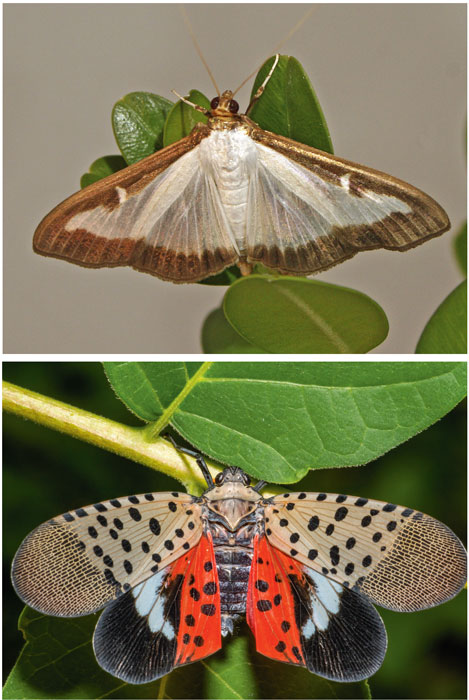4/1/2024
Reducing The Risk
Jennifer Polanz

There’s nothing worse for a gardener or grower than to baby your plants along, providing the best of what they need, and then get hit with a pest or disease issue.
Whether it’s in the home garden, at the garden center or in greenhouse or nursery production, pests and diseases are the bane of every plant-lover’s existence and can wreak havoc on the best laid plans. Here we’re going to take a dive into two different aspects of pests and diseases—the 30,000-ft. industry and regulatory view, and the granular what-gardeners- see view, and talk about how both impact retailers of all types.
Pictured: An adult box tree moth, which typically has a white body with a brown head and abdomen tip. • Now found in 17 states, spotted lanternfly continues its movement west and is a pest retailers should stay aware of.
The Bigger Picture
For the industrywide viewpoint, I reached out to AmericanHort and talked to Craig Regelbrugge, who’s been an advocate for our industry on the regulatory side for more than 30 years. He’s stepping back into a narrower role at AmericanHort, but is still involved as an advisor and leads on plant health trade issues.
“The priority is reducing risks and protecting the integrity of the industry supply chain,” Craig said. “A lot of what we do is attempting to keep the supply chain for the industry healthy, fair and reasonable for people who are buying, selling and installing plants.”
That means constantly troubleshooting problems when they come up and looking at potential issues that could be bigger problems industrywide. For example, they have a couple of key pest and disease issues they’re focused on right now that have the potential to impact the whole industry.
One of the main focuses is on boxwood, with two separate issues impacting the high dollar-value crop, which is the No. 1 evergreen shrub in the U.S. Boxwood blight is a fungal disease caused by Calonectria pseudonaviculata and results in the defoliation of the shrub. Boxwood blight has been an issue since 2011 and there are currently blight-resistant options available, alleviating some of the challenges surrounding this disease.
Box Tree Moth, or Cydalima perspectalis, is an emerging issue affecting Canada and is just beginning its spread in the U.S. (currently, it’s been found in limited infestations primarily in Michigan, Ohio and New York). This pest also results in the defoliation and ultimate weakening and death of the boxwood.
“Right now these infestations are limited, but likely to spread,” Craig said. “So this one for us has been all-hands-on-deck to mobilize the research agenda to figure out what tools we have now and what we can develop to deal with the pest.”
Fortunately, the pest hasn’t currently been found in a lot of the same areas as major boxwood production nurseries, and AmericanHort is working on a certification program with USDA and the states that can be put in place proactively to ensure growers have mitigation protocols in place before the pest arrives on their doorstep. He added there are a number of pesticides that are effective against our cover caterpillar and researchers are evaluating natural enemies of the pest as biocontrols. There are even options that involve mating disruption that are novel approaches to controlling Box Tree Moth.
“From a retailer standpoint, we want to make sure retailers can still get pest-free plant material, and two, the consumer marketplace doesn’t panic and suddenly decide boxwood is not a viable garden plant,” he said. “We think there’s a bright future and we’ll be able to live with this pest by following a multi-pronged approach. We’re optimistic about the future; we just have to get through the transition period.”

Ensuring Clean Starts
There’s a lot happening on the regulatory side to ensure retailers and the end consumer receive plants that are free from pests and diseases. For example, AmericanHort has worked closely with U.S. breeding companies and the USDA through multi-year negotiations to create an offshore greenhouse certification program. What does that mean? Young plant cutting producers have operations offshore, many of which are in Latin America, and through this program, they have to meet high standards in how they design and operate their growing facilities, Craig said.
Pictured: The impact of boxwood blight.
If they meet these standards they can become certified, which is a proactive way to ensure that what they ship to the U.S. is going to be free from pests and diseases, resulting in fewer USDA inspections that slow down shipping.
“Ninety percent of their shipments are actually bypassing the USDA inspection process and the supply chain moves faster,” Craig said. “The USDA has high confidence they are producing clean material and they don’t lose a day in inspections. The rooting stations get better quality product, which means greater success and that passes to the retailer.”
The certification program is one of those success stories involving partnership from many big players in our industry that often doesn’t get enough celebration. Moving clean products faster is a win for everyone.
In the U.S., there’s a similar voluntary auditing program called Systems Approach to Nursery Certification, or SANC, that certifies nursery growers are shipping pest- and disease-free stock.
“I think the smart retailers these days are going to be thinking about how they manage their risks, and will be thinking about choosing reliable partners and knowing their sources,” Craig added. “I think going forward the savvy retailers are going to want to choose reliable partners and asking, ‘Are you in SANC? If not, have you looked at it?’”
Regulatory Impact on Retail
Not every retailer has experienced this, but some have been impacted by state regulatory agencies and their actions to attempt to mitigate pest and disease concerns. An example Craig gave is rose mosaic, which isn’t the same as the virus that causes the more serious Rose Rosette Disease, but New England regulators still looked for symptoms and issued a stop sale order for plants showing the mosaic virus. Sometimes these viruses and diseases may not impact the plants we’re selling, but could have larger impact on other crops if they’re out in the landscape, giving state regulators broad powers in issuing orders of stop sales, which require the retailer or grower to destroy the plants.
“Where our industry is under a magnifying glass is when we rightly or wrongly are seen as the vector that’s moving around certain types of pests that can jump over and move to other types of crops,” Craig added. “They’re watching us and expecting us to do the right thing in keeping our plants in commerce clean.”
At the Home Gardener Level
Now that we’ve take a wider view of the industry and its actions on pests and diseases, let’s zero in a little closer on the home gardener and what they’re experiencing. To start off with, there’s the continued movement of spotted lanternfly, which PestTalks editor JC Chong did a fantastic job of updating in our March issue of GrowerTalks.
Just to recap that, the beautiful, yet destructive, pest can now be found in 17 U.S. states and continues its movement through the U.S., including most recently in Illinois, Kentucky and Tennessee. JC wrote that quarantines have been imposed on the movement of goods and equipment, including horticultural products, from several counties in seven states. It feeds on a range of fruit and ornamental trees, and prefers tree of heaven as one of its main hosts.
For a grower and home gardener viewpoint, I contacted Heidi Lindberg at MSU Extension, who said spotted lanternfly has been found in one location in Oakland County, Michigan so far, and MSU Extension and the Michigan Department of Agriculture (MDARD) have been working together to educate nurseries and the public about the new pest.
“MDARD did a media campaign last year on ‘See it. Squish it. Report it.’ to try to inform people about that invasive insect,” she said. “The challenge with spotted lanternfly is that it moves on trucks, shipping pallets, boats and other objects moving on roads.”
I asked Heidi about other pests she and her consumer hort team regularly hear about from gardening consumers and she noted annual problems like grubs in lawns, tree diseases, and pests like wasps, hornets and yellowjackets often come up. On the annuals and perennials side, they hear about slugs, Japanese beetles, aphids, and powdery and downy mildew (on shade plants) the most.
Her top concerns this year, too, include Box Tree Moth, which has been spotted in 12 southern Michigan counties, though it hasn’t reached the western side of Michigan where many growers are located.
I asked her as extension, how they go about recommending solutions.
“Most consumers don’t know the primary problem that is causing the plant issue, so the best way to problem-solve is to first ask for high-quality images, talk about the type of plant, growing conditions, and the type and onset of symptoms,” she said. “We start with images and a conversation, and if the consumer would like a thorough diagnosis, we instruct them to submit a sample to the university’s diagnostics lab.”
On the retail side, she said the best way to solve issues is to encourage best practices in planting and growing conditions to mitigate issues before they start. And don’t hesitate to work with your local extension office, which can provide support.
“Encourage your employees to learn about the plants’ preferred growing conditions and try to match selections with their sites,” she said. “Feel free to recommend your local extension service, as they have a lot of experience with taking these calls and even has a large group of volunteers or master gardeners to answer lawn and gardening hotlines.” GP
More Resources
Visit links below to find out more about the pests discussed here and to sign up for free for JC Chong’s PestTalks e-newsletter to stay up to date.
Boxwood Health
PestTalks E-newsletter sign-up
Spotted Lanternfly